SKODA FABIA 2006 2.G / 5J Workshop Manual
Manufacturer: SKODA, Model Year: 2006, Model line: FABIA, Model: SKODA FABIA 2006 2.G / 5JPages: 258, PDF Size: 44.86 MB
Page 51 of 258
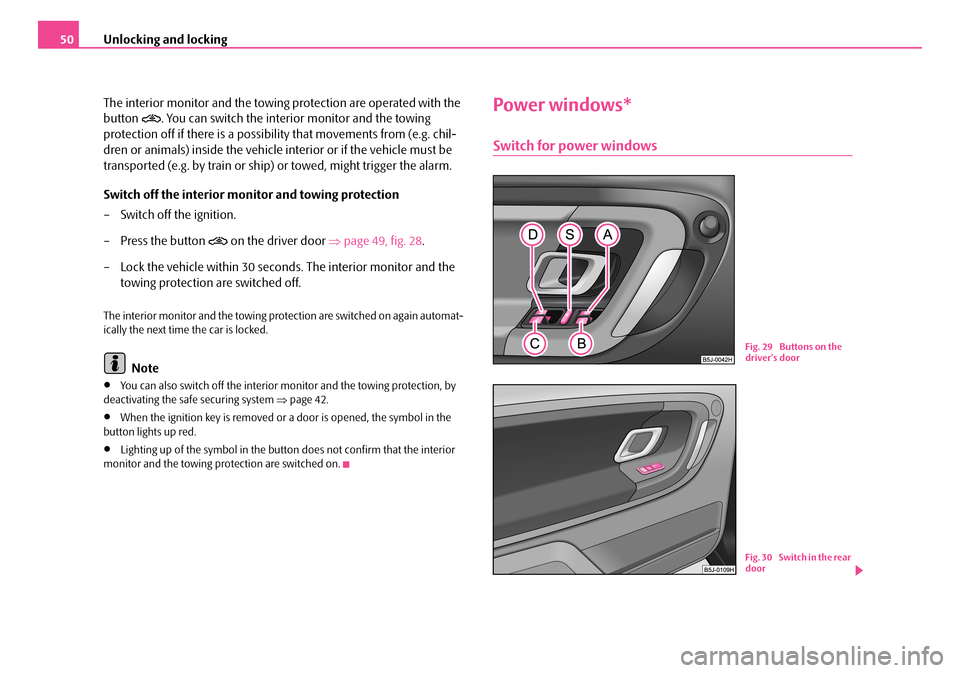
Unlocking and locking50
The interior monitor and the towing protection are operated with the
button . You can switch the interior monitor and the towing
protection off if there is a possibility that movements from (e.g. chil-
dren or animals) inside the vehicle interior or if the vehicle must be
transported (e.g. by train or ship) or towed, might trigger the alarm.
Switch off the interior monitor and towing protection
– Switch off the ignition.
– Press the button on the driver door ⇒page 49, fig. 28.
– Lock the vehicle within 30 seconds. The interior monitor and the
towing protection are switched off.
The interior monitor and the towing protection are switched on again automat- ically the next time the car is locked.
Note
•You can also switch off the interior monitor and the towing protection, by deactivating the safe securing system ⇒page 42.
•When the ignition key is removed or a door is opened, the symbol in the button lights up red.
•Lighting up of the symbol in the button does not confirm that the interior monitor and the towing protection are switched on.
Power windows*
Switch for power windows
Fig. 29 Buttons on the driver's door
Fig. 30 Switch in the rear door
NKO A05Fabia 20.book Page 50 Tuesday, September 26, 2006 8:38 AM
Page 52 of 258
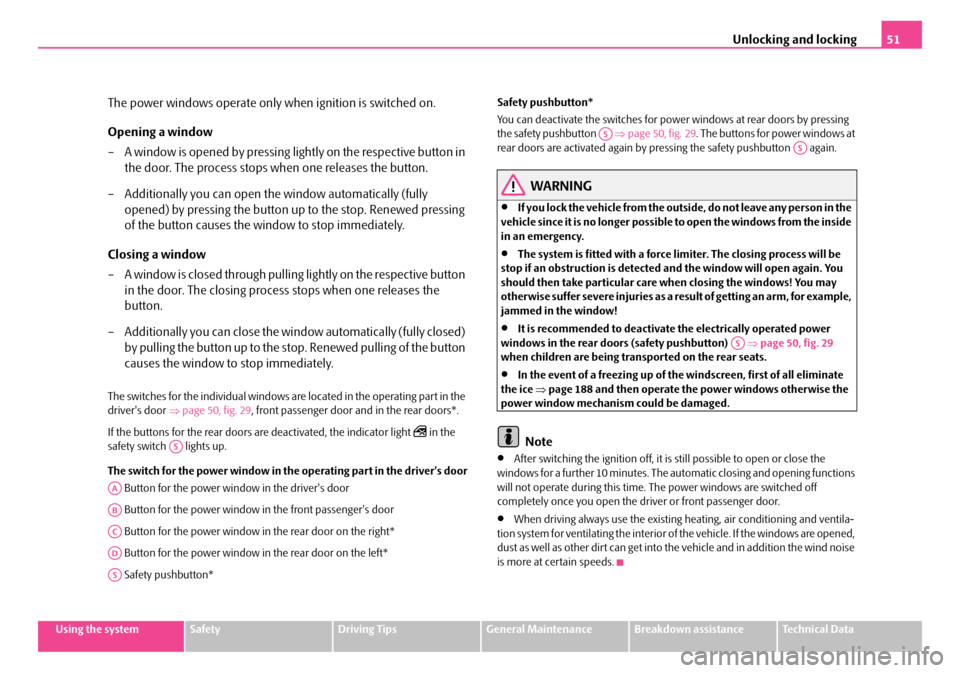
Unlocking and locking51
Using the systemSafetyDriving TipsGeneral MaintenanceBreakdown assistanceTechnical Data
The power windows operate only when ignition is switched on.
Opening a window
– A window is opened by pressing lightly on the respective button in
the door. The process stops when one releases the button.
– Additionally you can open the window automatically (fully
opened) by pressing the button up to the stop. Renewed pressing
of the button causes the window to stop immediately.
Closing a window
– A window is closed through pullin g lightly on the respective button
in the door. The closing process stops when one releases the
button.
– Additionally you can close the window automatically (fully closed)
by pulling the button up to the stop. Renewed pulling of the button
causes the window to stop immediately.
The switches for the individual windows are located in the operating part in the driver's door ⇒page 50, fig. 29, front passenger door and in the rear doors*.
If the buttons for the rear doors ar e deactivated, the indicator light in the safety switch lights up.
The switch for the power window in th e operating part in the driver's door
Button for the power window in the driver's door
Button for the power window in the front passenger's door
Button for the power window in the rear door on the right*
Button for the power window in the rear door on the left*
Safety pushbutton*
Safety pushbutton*
You can deactivate the switches for powe r windows at rear doors by pressing the safety pushbutton ⇒page 50, fig. 29. The buttons for power windows at rear doors are activated again by pre ssing the safety pushbutton again.
WARNING
•If you lock the vehicle from the outside, do not leave any person in the vehicle since it is no longer possible to open the windows from the inside in an emergency.
•The system is fitted wi th a force limiter. The closing process will be stop if an obstruction is detected and the window will open again. You should then take particular care when closing the windows! You may otherwise suffer severe injuries as a re sult of getting an arm, for example, jammed in the window!
•It is recommended to deactivate the electrically operated power windows in the rear doors (safety pushbutton) ⇒page 50, fig. 29 when children are being transported on the rear seats.
•In the event of a freezing up of th e windscreen, first of all eliminate the ice ⇒page 188 and then operate the power windows otherwise the power window mechanism could be damaged.
Note
•After switching the ignition off, it is still possible to open or close the windows for a further 10 minutes. The automatic closing and opening functions will not operate during this time. The power windows are switched off completely once you open the driver or front passenger door.
•When driving always use the existing heating, air conditioning and ventila- tion system for ventilating the interior of the vehicle. If the windows are opened, dust as well as other dirt can get into the vehicle and in addition the wind noise is more at certain speeds.
AS
AA
AB
AC
AD
AS
ASAS
AS
NKO A05Fabia 20.book Page 51 Tuesday, September 26, 2006 8:38 AM
Page 53 of 258
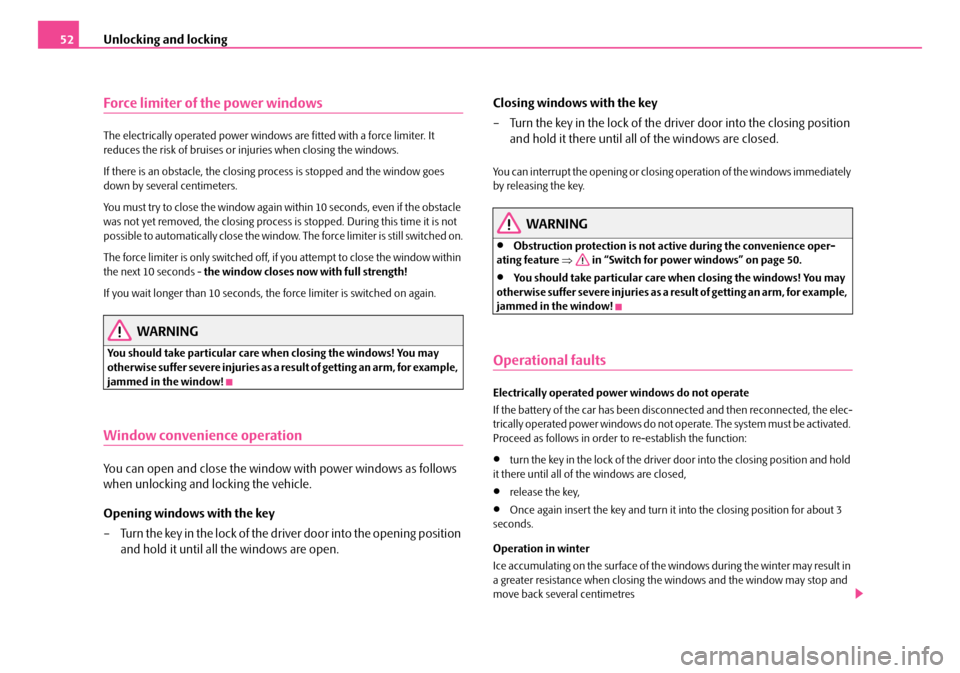
Unlocking and locking52
Force limiter of the power windows
The electrically operated power windows are fitted with a force limiter. It reduces the risk of bruises or in juries when closing the windows.
If there is an obstacle, the closing process is stopped and the window goes down by several centimeters.
You must try to close the window again wi thin 10 seconds, even if the obstacle was not yet removed, the closing process is stopped. During this time it is not possible to automatically close the window. The force limiter is still switched on.
The force limiter is only switched off, if you attempt to close the window within the next 10 seconds - the window closes now with full strength!
If you wait longer than 10 seconds, the force limiter is switched on again.
WARNING
You should take particular care when closing the windows! You may otherwise suffer severe injuries as a re sult of getting an arm, for example, jammed in the window!
Window convenience operation
You can open and close the window with power windows as follows
when unlocking and locking the vehicle.
Opening windows with the key
– Turn the key in the lock of the driver door into the opening position
and hold it until all the windows are open.
Closing windows with the key
– Turn the key in the lock of the driv er door into the closing position
and hold it there until all of the windows are closed.
You can interrupt the opening or closin g operation of the windows immediately by releasing the key.
WARNING
•Obstruction protection is not active during the convenience oper-ating feature ⇒ in “Switch for power windows” on page 50.
•You should take particular care when closing the windows! You may otherwise suffer severe injuries as a re sult of getting an arm, for example, jammed in the window!
Operational faults
Electrically operated power windows do not operate
If the battery of the car has been disconnected and then reconnected, the elec- trically operated power windows do not operate. The system must be activated. Proceed as follows in order to re-establish the function:
•turn the key in the lock of the driver door into the closing position and hold it there until all of the windows are closed,
•release the key,
•Once again insert the key and turn it into the closing position for about 3 seconds.
Operation in winter
Ice accumulating on the surface of the wi ndows during the winter may result in a greater resistance when closing the windows and the window may stop and move back several centimetres
NKO A05Fabia 20.book Page 52 Tuesday, September 26, 2006 8:38 AM
Page 54 of 258

Unlocking and locking53
Using the systemSafetyDriving TipsGeneral MaintenanceBreakdown assistanceTechnical Data
Proceed as follows to close the window fully:
•turn the key in the lock of the driver door into the closing position and hold it there until all of the windows are closed,
•repeat this operation until the window stops.
WARNING
•Obstruction protection is not active during the closing of the windows ⇒ in “Switch for power windows” on page 50.
•You should take particular care when closing the windows! You may otherwise suffer severe injuries as a re sult of getting an arm, for example, jammed in the window!
Electric sliding/tilting roof*
Description
The sliding/tilting roof is operated by means of the control dial ⇒fig. 31 and only functions when the ignition is switched on. The control dial has a number of fixed positions.
After switching the ignition off, it is still possible to open or close the sliding/tilting roof for a further 10 minutes. It is no longer possible to operate the sliding/tilting roof after opening or closing one of the front doors, however.
Note
•If the battery has been disconnected and reconnected, it is possible that the sliding/tilting roof does not close fully. Here you have to set the control dial to the switch position and press it forward for about 10 seconds.
•It is necessary after each emergency op eration (using crank handle) to move the sliding/tilting roof into the basic position. Here you have to set the control dial to the switch position and press it forward for about 10 seconds.
Opening and tilting
Comfort position
– Turn the switch to position ⇒fig. 31.
Opening roof fully
– Turn the switch to position and hold it in this position (spring-
tensioned position).
Tilting roof
– Turn the switch to position .
The wind noise in the comfort position is less than when the roof is fully opened.Fig. 31 Control dial for the power sliding/tilting roof
AA
AA
AC
AB
AD
NKO A05Fabia 20.book Page 53 Tuesday, September 26, 2006 8:38 AM
Page 55 of 258
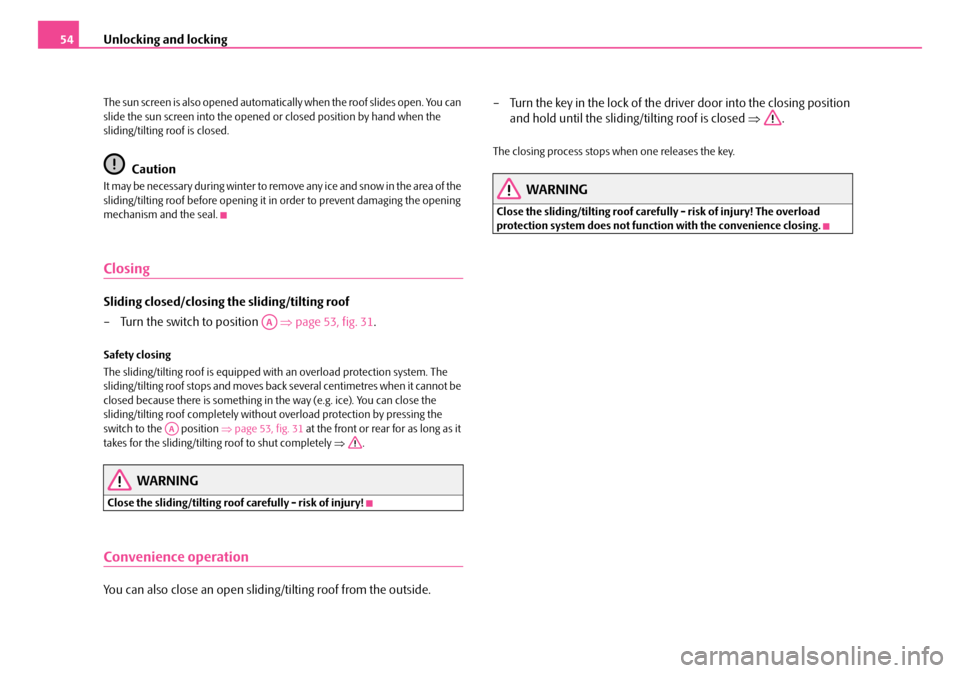
Unlocking and locking54
The sun screen is also opened automatically when the roof slides open. You can slide the sun screen into the opened or closed position by hand when the sliding/tilting roof is closed.
Caution
It m ay be ne ce ss ar y during winter to re move any i ce and s now in the a re a of the sliding/tilting roof before opening it in order to prevent damaging the opening mechanism and the seal.
Closing
Sliding closed/closing the sliding/tilting roof
– Turn the switch to position ⇒page 53, fig. 31.
Safety closing
The sliding/tilting roof is equipped with an overload protection system. The sliding/tilting roof stops and moves back several centimetres when it cannot be closed because there is something in the way (e.g. ice). You can close the sliding/tilting roof completely without overload protection by pressing the switch to the position ⇒page 53, fig. 31 at the front or rear for as long as it takes for the sliding/tilting roof to shut completely ⇒.
WARNING
Close the sliding/tilting roof carefully - risk of injury!
Convenience operation
You can also close an open sliding/tilting roof from the outside.
– Turn the key in the lock of the driv er door into the closing position
and hold until the sliding/tilting roof is closed ⇒.
The closing process stops when one releases the key.
WARNING
Close the sliding/tilting roof carefully - risk of injury! The overload protection system does not functi on with the convenience closing.
AA
AA
NKO A05Fabia 20.book Page 54 Tuesday, September 26, 2006 8:38 AM
Page 56 of 258

Unlocking and locking55
Using the systemSafetyDriving TipsGeneral MaintenanceBreakdown assistanceTechnical Data
Emergency operation
You can close the sliding/tilting roof by hand if the system is defect.
– Position the flat blade of a screwdriver carefully against the rear
edge of the cover of the electrical drive ⇒fig. 32.
– Pull the cover down.
– Take the crank handle out of the inside of the cover.
– Press the crank handle fully into the hexagon hole ⇒fig. 33.
– Hold the crank pressed and turn it - the roof closes.
– Insert the crank handle into the cover again.
– Press on the cover again by first of all inserting the plastic lugs and
then pushing the cover up.
– Have the fault rectified by a specialist workshop.
Note
It is necessary after each emergency operation (using crank handle) to move the sliding/tilting roof into the basic position. Here you have to press the control dial forward to switch position ⇒page 53, fig. 31 for about 10 seconds.
Fig. 32 Detail of the headliner: point for posi-tioning screwdriver
Fig. 33 Detail of the headliner: Emergency operation
A1A2
AA
NKO A05Fabia 20.book Page 55 Tuesday, September 26, 2006 8:38 AM
Page 57 of 258
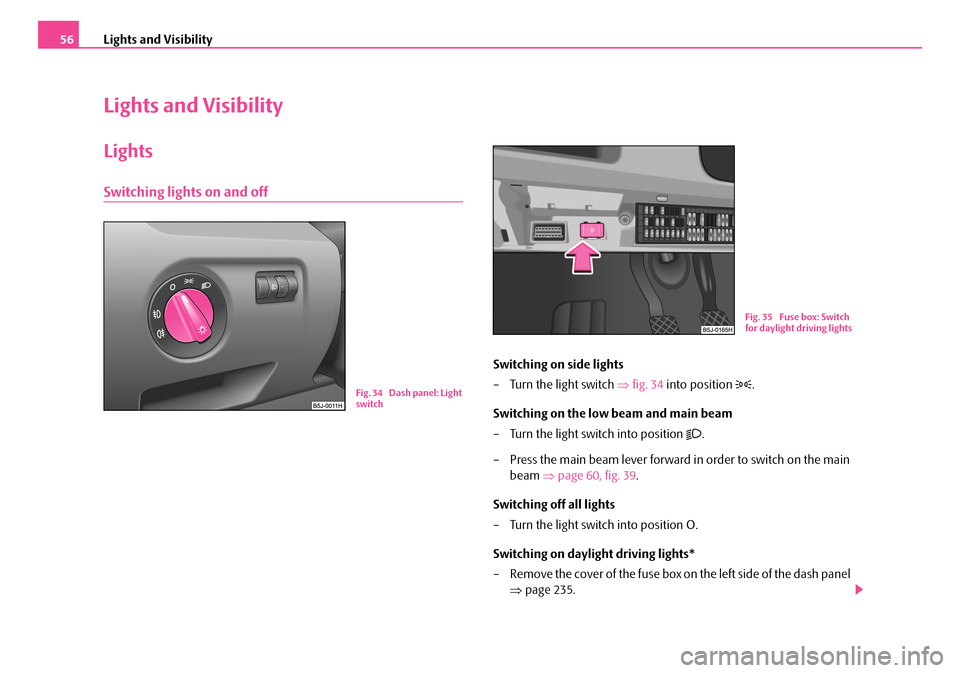
Lights and Visibility56
Lights and Visibility
Lights
Switching lights on and off
Switching on side lights
– Turn the light switch ⇒fig. 34 into position .
Switching on the low beam and main beam
– Turn the light switch into position .
– Press the main beam lever forward in order to switch on the main
beam ⇒page 60, fig. 39.
Switching off all lights
– Turn the light switch into position O.
Switching on daylight driving lights*
– Remove the cover of the fuse box on the left side of the dash panel
⇒ page 235.
Fig. 34 Dash panel: Light switch
Fig. 35 Fuse box: Switch for daylight driving lights
NKO A05Fabia 20.book Page 56 Tuesday, September 26, 2006 8:38 AM
Page 58 of 258

Lights and Visibility57
Using the systemSafetyDriving TipsGeneral MaintenanceBreakdown assistanceTechnical Data
– Turn the light switch into position O ⇒page 56, fig. 34.
– Switch on the switch for daylight driving lights ⇒page 56, fig. 35.
– After switching on the ignition the side lights are switched on.
– After starting the engine the low beam is switched on.
Switching off daylight driving lights*
– Switch off the switch for daylight driving lights ⇒page 56, fig. 35.
– Turn the light switch to the position side lights or low beam
⇒ page 56, fig. 34.
Low beam comes on only if the ignition is switched on. The low beam is switched off automatically when the engine is started and after switching the ignition off; only the side lights come on.
On models fitted with right-hand steering* the position of certain switches differs from that shown in ⇒page 56, fig. 34. The symbols which mark the switch positions are identical, however.
WARNING
Never drive with side lights on - risk of accident! The side lights are not bright enough to light up the road suffic iently in front of you or to be seen by other oncoming traffic. In this case, always switch on the low beam when it is dark or if visibility is poor.
Note
•An audible warning will sound if you wi thdraw the ignition key and open the driver's door when the vehicle lights are still on.
•The acoustic warning signal is switched off over the door contact when the driver's door is closed (ignition off). The vehicle can be parked with the side lights on.
•If you park the car for a lengthy pe riod, we recommend switching off all lights, or leaving only the side lights switched on.
•The switching on of the described lights should only be undertaken in accordance with the legal requirements.
•In the event of cool or humid weathe r conditions, the headlights can be misted up from inside.
− The temperature difference between interior and external area of the headlight lenses is decisive.
− When the driving lights are switched on, the light outlet surfaces are free from mist after a short period. The headlight lenses can possibly mist up at the border areas.
− It also concerns reverse light and turn signal lights.
− This mist has no influence on the life of the lighting system.
Cornering lights*
For a better cornering illumination the cornering lights are controlled in the optimal position in line with the vehicle speed and the steering angle.
If the warning light flashes for 1 minute while driving or after switching on the ignition and a warning signal sounds, a fault is confirmed.
WARNING
If there is a fault in the cornering lights, the warning light flashes in the instrument cluster. The cornering li ghts are automatically lowered to the emergency position, whic h prevents a possible dazzling of oncoming traffic. Thus the illuminated length of the road is shortened. Drive care- fully and have the car inspected i mmediately by a specialist garage.
NKO A05Fabia 20.book Page 57 Tuesday, September 26, 2006 8:38 AM
Page 59 of 258
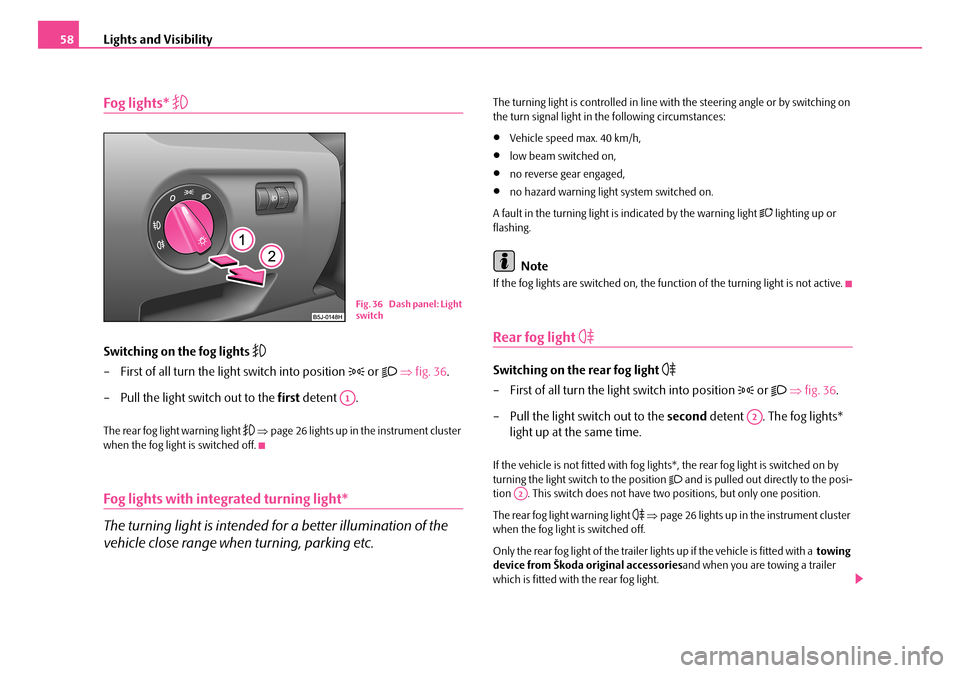
Lights and Visibility58
Fog lights*
Switching on the fog lights
– First of all turn the light switch into position or ⇒fig. 36.
– Pull the light switch out to the first detent .
The rear fog light warning light ⇒page 26 lights up in the instrument cluster when the fog light is switched off.
Fog lights with int egrated turning light*
The turning light is intended for a better illumination of the
vehicle close range when turning, parking etc.
The turning light is controlled in line wi th the steering angle or by switching on the turn signal light in the following circumstances:
•Vehicle speed max. 40 km/h,
•low beam switched on,
•no reverse gear engaged,
•no hazard warning light system switched on.
A fault in the turning light is indicated by the warning light lighting up or flashing.
Note
If the fog lights are switched on, the function of the turning light is not active.
Rear fog light
Switching on the rear fog light
– First of all turn the light switch into position or ⇒fig. 36.
– Pull the light switch out to the second detent . The fog lights*
light up at the same time.
If the vehicle is not fitted with fog lights *, the rear fog light is switched on by turning the light switch to the position and is pulled out directly to the posi- tion . This switch does not have two positions, but only one position.
The rear fog light warning light ⇒page 26 lights up in the instrument cluster when the fog light is switched off.
Only the rear fog light of the trailer lights up if the vehicle is fitted with a towing device from Škoda original accessories and when you are towing a trailer which is fitted with the rear fog light.
Fig. 36 Dash panel: Light switch
A1
A2
A2
NKO A05Fabia 20.book Page 58 Tuesday, September 26, 2006 8:38 AM
Page 60 of 258

Lights and Visibility59
Using the systemSafetyDriving TipsGeneral MaintenanceBreakdown assistanceTechnical Data
Caution
The rear fog light should only be switched on if visibility is particularly poor (conform with any varying legal provisions) to avoid dazzling vehicles behind your vehicle.
Headlamp range adjustment
Once the low beam is switched on you can then adapt the
range of the headlights to the load of the vehicle.
– Turn the control dial ⇒fig. 37 until you have adjusted the low
beam so that oncoming traffic is not dazzled.
Settings
The positions correspond approximately to the following vehicle loads:
Front seats occupied, luggage compartment empty.
All seats occupied, luggage compartment empty.
All seats occupied, luggage compartment laden.
Driver seat occupied, luggage compartment laden.
Caution
Set the headlight beam adjustment in such a way as to avoid dazzling oncoming traffic.
Switch for hazard warning lights
– Press switch ⇒fig. 38 to switch the hazard warning light system
on or off.
All the turn signal lights on the vehicle flash at the same time when the hazard warning light system is switched on. The indicator light for the turn signals and
Fig. 37 Dash panel: Lights and Visibility
A-
A1
A2
A3
Fig. 38 Dash panel: Switch for hazard warning lights
NKO A05Fabia 20.book Page 59 Tuesday, September 26, 2006 8:38 AM